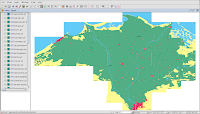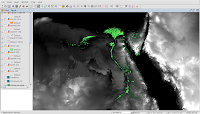News (well, a couple of weeks old) - I have now been accepted to do my PhD! I will be studying at Liverpool Uni and on a part-time basis, whilst I will be working at OA North. Can't wait to start!
Here is an excerpt from my proposal for whoever is interested:
My thesis will be concerned with capital cities in New Kingdom Egypt, focussing on major urban centres and their productivity. I intend to question whether and by what means a capital city could be defined and, in consequence, how far it contributed to Egypt's economy and wealth.
My core statement is that the presence of certain industrial establishments associated with an urban centre should be considered the major legitimisation of its status and wealth.
The outcome of my thesis will be an evolutionary model encompassing the emergence of urban centres in general and their industries until the end of the New Kingdom. Furthermore, I will be concerning myself with the establishment of a structural network based on the existence of industries within the cities of New Kingdom Egypt.
This approach will fill a significant gap in the current debate on Egyptian urbanism, providing an insight into relationships between industrial institutions and the seat of the administration and the king. My research will aid my career, preferably as a senior in fieldwork on an urban site, focussing on the development of major urban sites in Ancient Egypt.
I plan the evaluation of material remains known from urban production sites, such as the glass production sites at Amarna and Piramesse and the (later) metal and faience workshops at Thebes and Memphis. I will establish a database, which will enable me to filter the collected data into quantitative, local and functional groups and to be classified. This evaluation will take place with regards to the archaeological context and setting of the workshops. Thus, I will be able to gain insight into infrastructure and organisation of the cities, urban planning, and how far the production sites and their surroundings related to one another.
In addition to the local understanding of production sites within the capital cities, national networking will be of importance to understand the role of the capital as administrative centre, and royal seat as well as centre of distribution. The location of the city and its access to resources needs to be considered.
A discussion on international trade networks will highlight the roles and functions of Egyptian capitals of the period and their Middle Eastern equivalents.
Bibliography:
Baines, J. and N. Yoffee 1998. Order, Legitimacy, and Wealth in Ancient Egypt and Mesopotamia. In Archaic States, edited by G. Feinman and J. Marcus, pp. 199-260. Santa Fe: School of American Research Press.
Bietak, M. 1975. Tell el-Dab‘a II, Der Fundort im Rahmen einer archäologisch-geographischen Untersuchung über das ägyptische Ostdelta, Untersuchungen der Zweigstelle Kairo des Österreichischen Archäologischen Institutes; Band 1, Denkschriften der Gesamtakademie; Band 4, Vienna: Verlag der Österreichischen Akademie der Wissenschaften.
Bietak, M. 1979. Urban Archaeology and the "Town Problem". In Weeks, K. (ed.) Egyptology and the Social Sciences. Cairo: American University in Cairo Press, 95-144.
Bietak, M. 1981. Avaris and Piramesse: Archaeological Exploration in the Eastern Nile Delta. [Mortimer Wheeler Archaeological Lecture 1979] Oxford: Oxford University Press.
Bietak, M. 1984. Ramsesstadt, In Lexikon der Ägyptologie V, Wiesbaden: O. Harrassowitz, 128-46.
Bourriau, J.D., Phillips, J. (eds.) 2004. Invention and Innovation – The Social Context of Technological Change 2. Oxford: Oxbow Books.
Dorner, J. 1983. Archäologischer Survey in der Umgebung von Tell el-Dab'a, Jahreshefte des Österreichischen Archäologischen Instituts. Beiblatt 54 (Grabungen 1982), Vienna: Verlag der Österreichischen Akademie der Wissenschaften, 20-21.
Dorner, J. 1999. Die Topographie von Piramesse, Ägypten und Levante IX, Vienna: Verlag der Österreichischen Akademie der Wissenschaften, 77-83.
Friedman, F.D. (ed.) 1998. Gifts of the Nile: Ancient Egyptian faience. London: Thames and Hudson, c1998.
de Garis Davies, N. 1943. The Tomb of Rekh-mi-Re at Thebes. Metropolitan Museum of Art Egyptian Expedition 11. New York: Publications of the Metropolitan Museum of Art Egyptian Expedition.
Habachi, L. 2001. Tell el-Dab’a I: Tell el-Dab’a and Qantir, the site and ist connection with Avaris and Piramese; aus dem Nachlass herausgegeben von Eva-Maria Engel, Untersuchungen der Zweigstelle Kairo des Österreichischen Archäologischen Institutes; Band 2, Denkschriften der Gesamtakademie; Band 23, Vienna: Verlag der Österreichischen Akademie der Wissenschaften.
Hassan, F. 1993. Town and Village in Ancient Egypt: Ecology, Society and Urbanization. In Shaw, T., Sinclair, P., Andah, B. and Okpoko, A. (eds.) The Archaeology of Africa: Food, Metals and Towns. London: Routledge, 551- 586.
Hayes, W. 1937. Glazed Tiles from a Palace of Ramesses II. at Kantir, Metropolitan Museum of Art Papers; No. 3. New York: Ayer Company Publishers.
Hein, I., Janosi, P. 2004. Tell el-Dab’a XI: Areal A/V: Siedlungsrelikte der spaten Hyksoszeit,
Untersuchungen der Zweigstelle Kairo des Österreichischen Archäologischen Institutes; Band 25, Denkschriften der Gesamtakademie; Band 21, Vienna: Verlag der Österreichischen Akademie der Wissenschaften
Hodgkinson, A. 2007. The Final Phase of Per-Ramesses: The History of the
City in the Light of its Natural Environment. In Cannata, M. (ed.) Current Research in Egyptology VII: Proceedings of the Seventh Annual Symposium. Oxford: Oxbow Books, 99-115.
Kemp, B. 1977. The City of el-Amarna as a Source for the Study of Urban Society in Ancient Egypt. World Archaeology 9, London: Routledge. 124-139.
Kemp, B. 1989. Ancient Egypt: Anatomy of a Civilization. London: Routledge.
Lacovara, P. 1997. The New Kingdom Royal City, Studies in Egyptology, London: Kegan Paul International.
Nicholson, Paul 2007. Brilliant Things for Akhenaten: The Production of Glass, Vitreous Materials and Pottery at Amarna, Site O45.1. London: Egypt Exploration Society.
O'Connor, D. 1993. Urbanism in Bronze Age Egypt and Northeast Africa. In Shaw, T., Sinclair, P., Andah, B. and Okpoko, A. (eds.) The Archaeology of Africa: Food, Metals and Towns. London: Routledge, 570-586.
Patch, D. 1991. The Origin and Early Development of Urbanism in Ancient Egypt: A Regional Study. PhD Thesis, University of Pennsylvannia.
Pusch, E. 1994. Divergierende Verfahren der Metallverarbeitung in Theben und Qantir? Bemerkungen zur Konstruktion und Technik. Ägypten und Levante IV, 145-170.
Rehren, T. and Pusch, E. 1997. “New Kingdom Glass-Melting Crucibles from Qantir-Piramesses”, Journal of Egyptian Archaeology 83, London: Egypt Exploration Society, 127-142.
Shaw, T., Sinclair, P., Andah, B. and Okpoko, A. (eds.) 1993. The Archaeology of Africa: Food, Metals and Towns. London: Routledge
Pusch, E. B., Becker, H., Fassbinder, J. 1999. Wohnen und Leben. Oder: Weitere Schritte zu einem Stadtplan der Ramsesstadt, Ägypten und Levante IX, Vienna: Verlag der Österreichischen Akademie der Wissenschaften, 155-170.
Pusch, E. and Rehren, T. expected 2008. Hochtemperaturechnologie in der Ramses-Stadt. Rubinglas für den Pharao. Forschungen in der Ramses-Stadt 6, Mainz: von Zabern.
Uphill, E. P. 1968. Pithom and Raamses: Their Location and Significance, in: Journal of Near Eastern Studies 27, Chicago: University of Chicago Press, 291-316.
Uphill, E. P. 1984. The Temples of Per Ramesses, Warminster: Aris & Phillips.
Uphill, E. P. 1988. Egyptian Towns and Cities. Shire Egyptology 8, Princes Risborough: Shire Publications.
Saldern, A.; von Oppenheim, A.L. et al 1970. Glass and Glassmaking in Ancient Mesopotamia, Corning, Corning Museum of Glass.
Shaw, I. and Nicholson, P. (eds.) 2000. Ancient Egyptian materials and technology. Cambridge: Cambridge University Press.
Shortland, A.J. and Tite, M.S. 2005. A technological study of Ptolemaic – early roman faience from Memphis, Egypt, Archaeometry 47/1, Oxford: Blackwell Publishing, 31–46.
Trigger, B. 1972. Determinations of Urban Growth in Pre-industrial Societies. In Ucko, P., Tringham, R. and Dimbleby, G. (eds.) Man, Settlement and Urbanism. London: Duckworth, 575-599.
Trigger, B. 1985. The Evolution of Pre-industrial Cities: A Multilinear Perspective. In Geus, F. and Thill, F. (eds.) Mélanges offerts à Jean Vercoutter. Paris: Éditions Recherche sur les Civilisations, 343-353.
Van den Brink, E. (ed.) 1988. The Archaeology of the Nile Delta: Problems and Priorities. Amsterdam: Netherlands Foundation for Archaeological Research in Egypt/Uitgeverij.
Wengrow, D. 2006. The archaeology of early Egypt: Social Transformations in North-East Africa, 10,000 to 2650 BC. Cambridge: Cambridge University Press.
Yoffee, N. 2005. Myths of the Archaic State: The evolution of the earliest cities, states, and civilizations. Cambridge: Cambridge University Press.
This is only an excerpt produced for an online-application which requires a resumee of the whole thing. I am not yet courageous enough to publish my name here. Thus I suggest leaving a comment in case anybody is interested in my research/co-operation/exchange of information etc. Many thanks!
 Enjoy the view I had yesterday: The busy Smithdown Road can be seen in the background.
Enjoy the view I had yesterday: The busy Smithdown Road can be seen in the background. ...the best picture I could get - sneakily shot from the back of the bus!
...the best picture I could get - sneakily shot from the back of the bus!





























